Clothes & Equipment Needed For Working on an Industrial Site
- Posted on
- By SWSS
- 0

When it comes to working on an industrial or construction site, there are essential clothing and equipment that should be worn to stay safe and in compliance with the laws in Ontario.
Working on an industrial site demands careful attention to safety and practicality. Proper clothing and equipment contribute to this safety and are essential for protecting oneself from potential hazards.
From head to toe, we've put together a list of attire and gear that's necessary for a safe and productive workday while in an industrial setting or construction site environment.
Protective Headgear and Accessories
When it comes to safeguarding the most vital part of your body - your head, there's absolutely no room for compromise. Wearing head protection is non-negotiable in industrial environments where falling objects and various other overhead hazards are quite common.
Here's what you need to ensure head safety:
Hard Hats
- Ensure your hard hat meets CSA standards for safety.
- Regularly inspect your hat for cracks or damage.
- Replace any damaged hard hats immediately.
- Choose a hard hat with adjustable straps for a secure fit.
Safety Glasses and Goggles
- Required to protect your eyes from debris, chemicals, and flying particles.
- Opt for CSA-approved safety glasses or goggles.
- Clean and inspect them regularly for any scratches or defects.
- Familiarize yourself with the laws on wearing safety glasses in Ontario for compliance and safety assurance.
Ear Protection
- Ear protection guards against hearing loss caused by loud machinery or equipment.
- Use earplugs or earmuffs that meet safety standards.
- Always wear ear protection consistently, especially in noisy environments.
- Store your ear protection in a clea and dry place so as to maintain their effectiveness.
Respiratory Protection
- Shields yourself from harmful dust, fumes, and vapours.
- Choose a respirator that's appropriate for the specific hazards in your work environment.
- Conduct regular fit tests to ensure a proper seal.
- Replace the filters regularly so as to maintain their effectiveness.
Protective Clothing and Footwear
Industrial work environments can pose a number of risks to the human body, making appropriate clothing and footwear highly important for personal safety and comfort.
Here's what you need to stay safe:
Workwear
- Wear durable, flame-resistant clothing that minimizes the risk of burns or injuries.
- Choose garments with reflective strips to increase visibility in low-light conditions.
- Try to avoid loose clothing that can easily get caught in machinery or equipment.
- Regularly inspect your clothing for wear and tear, and damage.
Safety Footwear
- Invest in CSA-approved safety boots with steel toes and puncture-resistant soles.
- Ensure a proper fit to prevent blisters or discomfort.
- Replace footwear when signs of wear or damage appear.
- Clean and maintain your footwear on a regular basis to prolong its lifespan.
Hand Protection
- Shield your hands from cuts, abrasions, and chemical exposure.
- Select gloves that are designed for the specific tasks and hazards you encounter.
- Inspect gloves before each use for tears or holes.
- Replace gloves as soon as you see signs of wear or deterioration signs appear.
Simply Put: Take Control of Your Safety
Now that you're aware of which protective clothing to purchase, it's time to go out and purchase them. Before each piece that you buy, just make sure they comply with safety standards and regulations in the state or province you work in.
Inspect your gear, invest in quality protective wear, and familiarize yourself with local laws because these proactive steps can make all the difference in staying safe and productive on the job.

Comments
Be the first to comment...